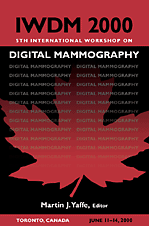
Digital Mammography: IWDM 2000, 5th International Workshop
Author: Martin YaffeISBN: 9781930524002
Published: 2001 | 856 pp. |
OUT OF PRINT
Clinical Imaging | May/June 2002
"In this volume, the proceedings of the 5th International Workshop on Digital Mammography, which was held in Toronto (Canada) on June 11-14, 2000, are reported. The numerous contributors, representing both academia and industry, have discussed the development, assessment, and utilization of digital mammography.
"The section related to 'Image Acquisition', discussed different aspects of digital mammography, such as: Microcalcification - Is Digital Luminescence Mammography Equal to Film-Screen Systems? By U. Aichinger et al.; Quantitative Analysis and Qualitative Performance of Flat-Panel Detector for Digital Mammography, by A. Debrie et al.; Comparison of Different Detector Materials for Digital Mammography, by N.L. Ford et al.: Decreased Breast Compression Using Digital Mammography at Screen/Film Mean Glandular Dose, by C. Kimme-Smith et al.; Merits of Using a 3-D Visualization Technique to Target Microcalcifications, by B. Leduc et al.; Improvement in Digital Mammography with Synchrotron Radiation, by R. Longo et al., to mention only a few.
"Numerous reports were given on the subject of 'Computer-Aided Detection', among them are the following: A. Mouloud on the Quality Control of Mammographic Images: Automated Detection of Microcalcifications in Phantom Images; M.J. Bottema related on the Detection of Microcalcifications Associated with Cancer; the Automatic Detection of Clustered Microcalcifications Using a Combined Method and an SVM Classifier was discussed by A. Bazzani et al.; a Computerized Classification of Lesions on Digital Mammography was presented by M.L. Giger et al.; Y. Hagihara et al. showed their satisfactory experimental results in an Accurate Detection of Microcalcifications on Mammograms by Improvement of Morphological Processing; M. Heath et al. reviewed The Digital Database for Screening Mammography; F.L. Valverde et al. reported on the Elimination of Calcified False Positives in Detection of Microcalcifications in Mammograms Using Hough Transform; and the Application of Compter-Aided Diagnosis to Full-Field Digital Mammography was discussed by M. Laura et al.
"Several Contributors dealt with the 'Clinical Aspects' of digital mammography, to mention a few: S. Liu et al. analyzed the Characterization of Normal Mammograms; E. Pisano et al. discussed the Accuracy of Digital Mammography vs. Screen-Film Mammography in a Diagnostic Mammography Population; and Digital Mammography: Utility, Future Clinical Roles, Limitations was clearly discussed by E.A. Sickles. Several interesting communications dealing with 'Image Processsing' were presented, such as: Enhancement of Low Contrast Features in Mammograms, by E.E. Caselli et al.; M. Masek et al. present their procedure for the Automatic Removal of High-Intensity Labels and Noise from Mammograms; and H. Heiber et al. dealt with the Local Contrast Enhancement for the Detection of Microcalcifications.
"Topics on 'Quality Control' and 'Quantitative Image Analysis' were also discussed. In the latter section, to mention only a few reports, C.P. Behrenbruch et al. discussed The Generation of Simulated Mammograms from Contrast Enhanced MRI for Surgical Planning and Post-operative Assessment; A. Bloomquist et al. reported on their preliminary results on Estimating Breast Density Using a Volumetric Technique and Full-Field Digital Mammograms; An Automated Classification Method for Mammograms Based on Evaluation of Fibroglandular Breast Tissue Density was illustrated by T. Matsubara et al.; and also interesting was the Three-Dimensional Reconstruction of Microcalcification Clusters from Two Mammographic Views, a novel algorithm presented by M. Yam et al.
"This book, in which the proceedings of the 5th International Workshop on Digital Mammography were collected, presents reports on the different aspects, advantages, and on the state of development of digital mammography, which will be of importance to all those who are interested in the applications and future of this technology."
Antonio F. Govoni, MD


